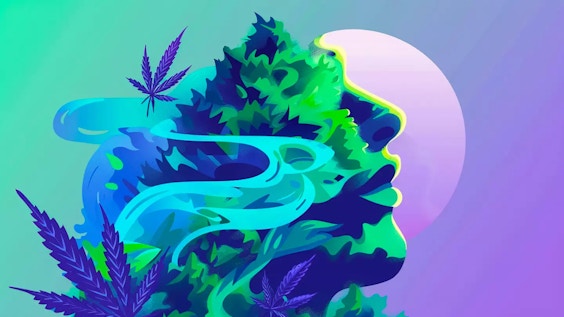I Am Sober is a free app that helps you get some control back in your life.

Withdrawal from Marijuana
Last Updated: Fri, March 29, 2024Marijuana withdrawal symptoms include restlessness, decreased appetite, nausea, abdominal pain, insomnia, worsening of cognitive impairment, anxiety, irritability, mood swings, and depression.
It is possible to become dependent on marijuana without becoming addicted, but typically, showing symptoms of withdrawal is indicative of cannabis use disorder. THC attaches to endocannabinoid receptors, which effect various brain functions such as problem solving and learning new skills. When these processes are interrupted by THC with repeated use, it becomes harder for the brain to recalibrate these functions.
Withdrawal symptoms can start as early as 24 hours since last use. Depending on your level of dependence, symptoms may not begin until 3 days out.
Marijuana Withdrawal Symptoms
Withdrawal symptom severity depends on how long the person used for, what means they consumed (smoked/ingested), and the amount ingested. Marijuana withdrawal symptoms typically start 1-3 days from the last dose. This is also when symptoms are at their peak.
Women tend to experience worse symptoms than men, such as more nausea and stomach pain.
Withdrawal symptoms from marijuana can include:
-
Cannabis craving
-
Irritability
-
Nervousness/anxiety
-
Nausea
-
Restlessness
-
Irritability/anger
-
Aggression
-
Insomnia
-
Strange/wild dreams
-
Depression
-
Decreased appetite
-
Sweating
-
Fever
-
Chills
-
Headache
-
Shakiness/tremulousness
-
Headaches
-
Sweating
-
Stomach pain
-
Mood swings
-
Weight loss
In the brain, cannabinoids communicate and control our appetite, mood and memory. THC bonds to these receptors and affect these functions, causing increased appetite. Because of this, many people suffer weight loss when they quit marijuana.
Additionally, THC also connects to receptors that affect our waking and sleeping cycles, which may be why withdrawal may cause insomnia and restlessness.
Marijuana Withdrawal Timeline
Marijuana withdrawal starts between 1 and 3 days after the last use, peaks between the second and sixth day, and typically lasts about 2 weeks. Again depending on the amount used and the amount of time used, the timeline will vary.
Days 1-3: During the first few days when withdrawal sets in, it’s very common to experience restlessness, difficulty sleeping, anxiety, irritability and a general lack of focus or inability to focus. More severe cases may experience tremors or insomnia.
Days 4-7: For many, the symptoms in days 1-3 carry over into days 4-7. In addition, however, some notice abdominal cramps, nausea, headaches, sweating, chills, loss of appetite and weight loss. In addition, this is when cravings tend to set in.
Days 7-10: During this time period, cravings, irritability and a lack of concentration continue to varying degrees. However, this is also when mood swings, aggressive behavior, sleep disorders, and mild depression can manifest.
Days 11-14: The withdrawal symptoms that remain at this point are insomnia, mild depression, anxiety, and a frequent cough (if marijuana was primarily smoked).
The long term effects of marijuana on fully developed adults are still up for debate, but for youths and adolescents some of the changes to cognitive function are permanent. The ability to problem solve and learn new skills becomes much more challenging.
That said, even in adults, many have reported ongoing memory problems, mild depression, and a lack of motivation.
How To Handle Marijuana Cravings
Relapse continues to be one of the most trying aspects of addiction, made all the worse by cravings. One of the challenges with marijuana is, with its increasing legal status, it’s very easy to come by regardless of your environment.
To counteract cravings, there are several things you can do.
-
Never crave alone. Develop recovery supports you can talk to when you are craving. Talk out your cravings by talking about the good things that will happen if you don’t use, the bad things that will happen if you do use, what might be triggering your craving,and what you can do to soothe and distract yourself.
-
Leave the situation if it is triggering you. Avoid the people, places, and things that go along with marijuana use. Wherever you are and whatever you’re doing may be a trigger. Remove yourself from the situation even if it’d conventionally be referred to as a faux pas.
-
Soothe yourself. Use breathing and relaxation techniques. Go for a walk. Listen to music. Take a bath. Ideally, this will calm your body, making you able to see the big picture instead of the immediate gratification of marijuana.
-
Distract yourself. Find a new activity. If you become fixated on using marijuana, then you need to find another activity to busy yourself with. The best kind of activity is something physical where you end up concentrating on the task at hand instead of thinking about using marijuana. A jog, a pickup game, or workout are all great ways to stay sober.
Marijuana Withdrawal Treatment
The US Food and Drug Administration (FDA) currently has not approved of any drugs or medications to specifically treat marijuana withdrawal. However, due to withdrawal typically causing an increase in anxiety and restlessness and sleep disorders, doctors often prescribe medication to target those symptoms.
Evidence indicates that gabapentin may be useful for the anxiety of withdrawal. An antidepressant called mirtazapine may help for depression and insomnia. Avoid the antidepressant venlafaxine—it can make withdrawal worse.
There are ongoing clinical trials to aid marijuana withdrawal symptoms. The two main drugs being tested with are buspirone (and anti-anxiety medication) and zolpidem (a sleep aid). Buspirone can help for sleep. Zolpidem (Ambien) can help for insomnia.
Beyond medication, many people pursue therapy to stay sober while going through withdrawal. For one, there is cognitive-behavioral therapy (CBT) to help marijuana users recognize unhelpful triggers, thoughts, and behaviors. CBT helps marijuana users make healthier decisions. Another therapy is motivational enhancement therapy (MET) MET helps boost motivation to stay sober.
While marijuana withdrawal is painful, it is safe and temporary. Most people can go through it on an outpatient basis. Get treatment to help make the process more bearable. If you are going through withdrawal, keep thinking about the long-term benefits you will experience. With marijuana withdrawal, shore-term pain does result in long-term gain.
More resources
I Am Sober is a free app that helps you get some control back in your life.





